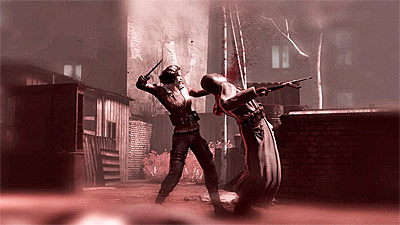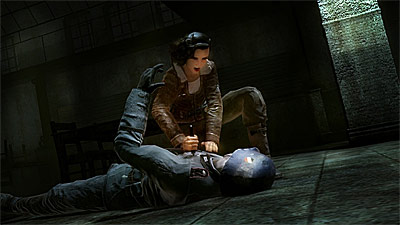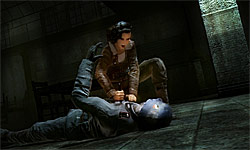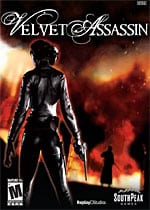Death Becomes Her
Velvet Assassin is a stealth title that places players in the heart of Nazi-occupied Europe. While the game fails to innovate upon established genre conventions, it does a remarkable job of providing players with a puzzle-like experience. I suppose many players will get frustrated with the plodding pace and linearity of the game, however, others will find the meticulous approach with which levels need to be cleared exceedingly enjoyable. Moreover, the dark and eerie settings are perfectly rendered; aptly lending themselves to complete immersion in the tale being spun.

The game is set in 1944, and it is based on the covert actions of the decorated British Special Operations Executive (SOE) agent Violette Szabo. Szabo, a mother and soldier’s widow, died at the age of 23 after being apprehended by the Nazis while reorganizing the heavily disrupted French resistance, the Maquis. Szabo was beaten, raped, malnourished, and forced into hard labor by the occupying force until her death in Ravensbrück concentration camp in February of 1945. With this darkest of backdrops as a guide, the introspective German developer Replay Studios has players take on the role of Violette Summer – a fictional character developed in the mold of Violette Szabo.
As Violette Summer, players will be charged with infiltrating and destroying strategic Nazi installations across Europe and taking out key members of their leadership and even captured friends. Told in medias res, players will see the story unfold via a series of feverish flashbacks from the perspective of a bed-ridden Violette Summer who’s strung out on morphine. This sets up each of the 12 missions as relived memories, and it also paves the way for the implementation of Morphine Mode (more on that later). Armed with little more than a knife and cat-like cunning, gamers are forced to make their way through the objectives relying almost entirely on stealth. Fortunately, the game’s sneaking mechanics are very well employed and quite enjoyable to use. Hiding in the shadows and using the environment will provide players with nearly absolute cover. Of course, enemies can still spot you if you are even remotely careless. That means acting patiently yet decisively is a must.
Upon entering a new section, players will have to crouch into position and analyze the situation. This can be done by eavesdropping on enemy guards, looking for interactive objects in the environment (such as radios, breaker boxes, and hazardous materials), observing guard behavior, and quickly devising a method of attack and escape. This makes the levels’ sections feel like puzzles. I thoroughly enjoyed coming up with a plan and, literally, executing it to perfection. If I got the least bit silly, or if I tried to do things unreasonably, I would pay the price with a quick death, having to then start over from the last saved checkpoint. Occasionally, this can get frustrating. But, eventually, the tactic for tackling a set of rooms, prison corridors, or a section of urbanization becomes apparent. On the downside, level design is fairly linear. Sure, sometimes you can choose from forking routes from a central hub, but once you are on that path there is little variation to be found. Sporadically, a secondary tunnel, secret path, or side room will allow you to dispatch with foes more easily, give you access to key implements and weaponry, or reward you with invaluable collectibles. Still, slinking along amongst the shadows and bushes is typically the best choice.

That being said, there are a few other alternative stealth tactics that can be employed. For example, Violette can turn off a radio or give a little whistle to lure a guard into a trap. Also, you can break fuse panels to turn out lights and sometimes you can even set oil pools alight or electrocute baddies stuck in standing water. These tools serve to help players get through sections in a rewarding and creative fashion. Unfortunately, some things don’t always work quite the way they should. For instance, standing in front of a light source in a cove that projects your shadow on the wall won’t alert enemies. This speaks volumes to the overall stupidity of the enemy A.I.; these automatons pace around predictably and rarely react to their surroundings.
When stealth isn’t enough, the game does provide you with some weapons, but clearly Violette Summer is not a highly-trained professional. Don’t expect to be able to blast your way out of a hairy situation, as the shooting mechanic is woefully meager. I didn’t find this to be a problem, however. After all, more than 90% of the kills you will make in this game will be done from behind with a knife. Although, shooting gallery sections are tedious and should’ve been dropped or vastly improved.

If all else fails, as previously alluded to, a peculiar mechanic called Morphine Mode is used in the game. Essentially a glorified bullet-time system, whenever players encounter a situation that can’t be effectively circumvented, Morphine Mode will have players shift into a temporary dream-like state where Violette prances around in her lingerie, allowing you to efficiently deal with these threats. While this may sound wacky, it somehow works within the context of the story.
Of course, you’ll not be able to constantly use this tool, as morphine drops are very limited and Violette can only carry a maximum of three syringes. While I found Morphine Mode to be interesting, it seemed to be superfluous and in effect Nerfed the experience. It could have easily have been dropped from the game entirely, forcing the devs to only moderately change the level design.

Players will advance through the levels and find a number of collectible items. Not only does this promote a modicum of exploration, it also will garner you experience points. For every 1000 points of EXP accumulated from the hidden objects, players will be given an upgrade star to enhance one of three abilities: Morphine, Stealth, and Strength. Improved Morphine will both increase the effect’s duration as well as allow you to carry up to three syringes when maxed out. Stealth will allow you to move much more quickly while crouched. Finally, increased Strength simply allows you to take more damage before dying. While upgrading the character made collecting rare objects from the environment more important, the simplistic level progression could also have been easily done away with, as improving her skills felt tacked on.
In terms of visuals, the overall package is very good but suffers from a few glaring errors. The environments are varied and wonderfully creepy; the lighting effects in particular are astounding. Also, the brutal kill animations are both visceral and fun to watch. On the downside, there is rampant slow down to be found, an abundance of disappearing walls, and the enemies are all clones with a paltry bit of class variety. A more polished graphical presentation would have been greatly appreciated. Aurally, the game is quite good. While the stealth genre means there isn’t much in the way of music, the ambient sounds and enemy conversations are brilliant. In particular, the German dialogue is outstanding. The banter between troops not only sets the tone but gives the enemies a lot more depth than their cookie cutter appearance belies. I often found myself waiting for a couple extra minutes at a time just listening to the stories conveyed by my unwitting victims; a calm before the storm if you will.
Velvet Assassin is likely a niche game that won’t be fully appreciated by all comers. That being said, there is a compelling story and a lot of fun gameplay to be found. Players interested in the title should make sure they have a good deal of patience and familiarity with the stealth genre. If you’re looking for some run-and-gun action, or even a nice mix of the two, you’ll likely be disappointed. Moreover, Velvet Assassin only offers a single-player campaign. There are no competitive multiplayer or cooperative modes, so other than challenging the highest difficulty setting, picking up all the collectibles, and scoring a higher mission rating, there’s not a whole lot of replay value. Armed with that knowledge, if you still fancy a go, you’ll quickly get hooked.
RATING OUT OF 5 RATING DESCRIPTION 3.5 Graphics
The game is generally beautiful to behold, with lighting effects really standing out, but some technical problems and generic-looking enemies are problematic. 4.0 Control
Sneaking around in stealth mode is nicely implemented. Pacing is slow, however, and using guns is definitely a last resort. 4.4 Music / Sound FX / Voice Acting
The voice over work, particularly the use of German by your enemies, is outstanding. More sound effects and atmospheric music would have been nice. 3.5 Play Value
You’ll either love it or hate it. I don’t see a lot of people falling somewhere in the middle. The lack of competitive and cooperative multiplayer modes, while not needed, doesn’t help the game’s replay value. 3.6 Overall Rating – Good
Not an average. See Rating legend above for a final score breakdown.
Game Features:
